This post originally appeared in the monthly farm animal welfare newsletter written by Lewis Bollard, our program officer for farm animal welfare. Sign up here to receive an email each month with Lewis’ research and insights into farm animal advocacy. Note that the newsletter is not thoroughly vetted by other staff and does not necessarily represent consensus views of Open Philanthropy as a whole.
Earlier this year the prestigious EAT-Lancet Commission called on the world to eat less meat to slow climate change. Three other reports in the last year echoed that message, including two published in Science and Nature, and one produced in partnership with two UN agencies and the World Bank. Even the normally cautious Intergovernmental Panel on Climate Change noted in its October report the “increasing agreement that overall emissions from food systems could be reduced by targeting the demand for meat and other livestock products.”
This marks a major change. The climate movement long ignored the inconvenient truth of meat’s greenhouse gas emissions — so much so that a hit documentary alleged a Cowspiracy between environmentalists and the meat industry. PETA activists grew so frustrated at Al Gore’s evasion of the issue that they trailed him in chicken costumes in a hummer, accusing him of being “too chicken to go vegetarian” (he later went vegan, though it’s unclear what role the chicken costumes played).
A lot has changed since then. Major environmental groups, including Greenpeace, the Sierra Club, National Resources Defense Council, World Wildlife Fund UK, World Resources Institute, and Friends of the Earth, now encourage people to eat less meat. Even the UN’s Environment Program and the World Economic Forum have highlighted animal agriculture’s contribution to climate change, as did The New York Times in a major feature this week.
This is welcome news for the climate. Animal agriculture contributes a substantial share of greenhouse gas emissions — though the best estimates peg it at 14.5%–16.5% globally, not 51%, as some activists claim based on one unpublished study. (The US percentage is lower, mainly because US total emissions are so large.) The Nature study’s authors warn that a global shift to a “flexitarian” diet is “essential” to keep temperature rises under the 2C cap by 2050.
This also sounds like welcome news for animals. Some animal advocates now argue that the global attention on climate change offers the best hope to end factory farming. So could we help farm animals by focusing more on the climate?
The law of unintended consequences
It’s complicated. The interests of environmentalists and animal advocates aren’t as aligned as we might wish. We need to be clear-eyed about the tradeoffs to ensure that planetary progress isn’t achieved at animals’ expense.
The starkest tradeoff is between the carbon footprint of different meats and the number of animals killed to make them. The FAO estimates that the 305M cattle slaughtered globally each year produce 5X more emissions than the 66.6B chickens slaughtered collectively do, while some models suggest the climate impact from the more than 1 Trillion fish slaughtered annually may be even smaller.
This has led some environmentalists to urge consumers to replace beef with chicken or fish. For example, this week’s New York Times meat and climate feature notes, “Eating as a pescatarian, adding seafood to a vegetarian diet, can be a good compromise, and makes it easier to get protein into your meals. To keep some meat in your diet, try cutting back to one serving of red meat per week, replacing the rest with chicken, pork, fish or plant proteins.”
This could result in many more animals suffering in factory farms. To produce as much meat as one cow takes about 185 chickens or 100 – 20,000 fish (depending on species), who will collectively spend 25 – 20,000 years in factory farms (vs. one cow spending up to a year in a feedlot).
Similarly, the much-touted EAT-Lancet’s “planetary health diet” called for consuming less red meat but more fish. As a result, if the world adopted the recommended diet, by 2050 land farm animal numbers would fall by 10-15B relative to 2050 baseline projections — but farmed fish numbers would increase by 50-100B. Seafood companies are now citing the Lancet report to bolster their case.
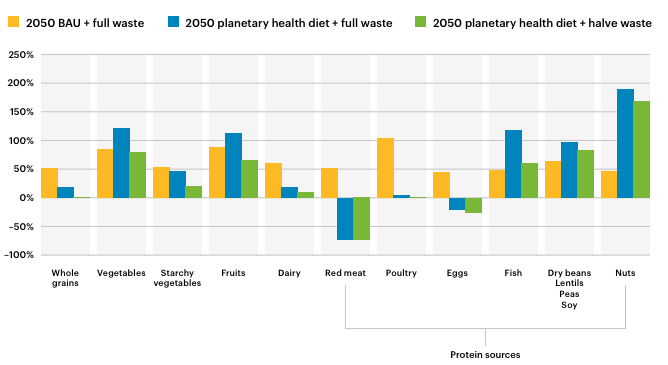
Even policies that don’t explicitly call for more chicken or fish consumption could still have that effect. The UK Committee on Climate Change models that adopting a more climate-friendly diet would “reduce dairy, beef and lamb numbers by up to 46% and increase poultry and pigs by around a quarter,” due to substitution effects. That would cause a net increase of 275M animals slaughtered annually in the UK alone. Institutional pledges to cut beef or food-related emissions by 20% or 50% will have a similar effect if institutions achieve their goals by replacing even a small portion of their beef with chicken.
A similar tradeoff exists between animals’ carbon footprint and their treatment. Most methane-belching ruminants spend most of their lives on pasture, while almost all chickens don’t. Within species, free-range chickens or cattle may generate higher emissions than their factory-farmed cousins.
This has led some environmental groups to support confining animals more tightly. For instance, some now promote recirculating aquaculture systems, in which each fish can receive less than one hundredth of the space she’d receive in a traditional pond farm. The WWF even questioned McDonald’s decision to go cage-free, because hens immobilized in battery cages take up less space and need less feed.
How to engage
So should farm animal advocates steer clear of climate advocacy entirely? I don’t think so. Climate advocates, fresh off big anti-coal wins, will increasingly focus on meat whatever we do. Animal advocates should be part of that conversation, especially to emphasize the following points:
First, white meat’s climate impact is often undercounted. Analyses of animals’ climate impacts often count only direct production, in which ruminants’ methane dominates. But once land use changes are factored in — for instance, clear cutting forests to grow feedstocks — chicken’s impact looks much worse (though not as awful as beef’s), as the graph below shows.
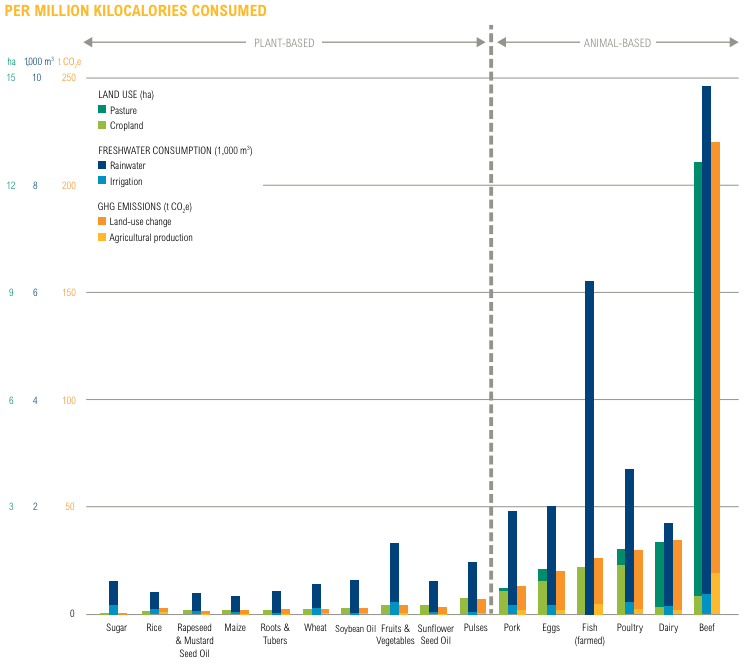
Similarly, analyses of fish’s carbon footprints often focus on low-carbon wild-caught fish common in Western diets, like cod, tuna, and pollock. But wild-caught fishing levels hit a limit two decades ago, so almost all marginal fish production comes from fish farming. And a 2018 analysis of 148 life cycle assessments of different animal products found that the world’s most commonly farmed fish species (shrimp, carp, and tilapia) had protein-adjusted carbon footprints higher than pork, and in some cases even higher than beef (see chart (b) below).
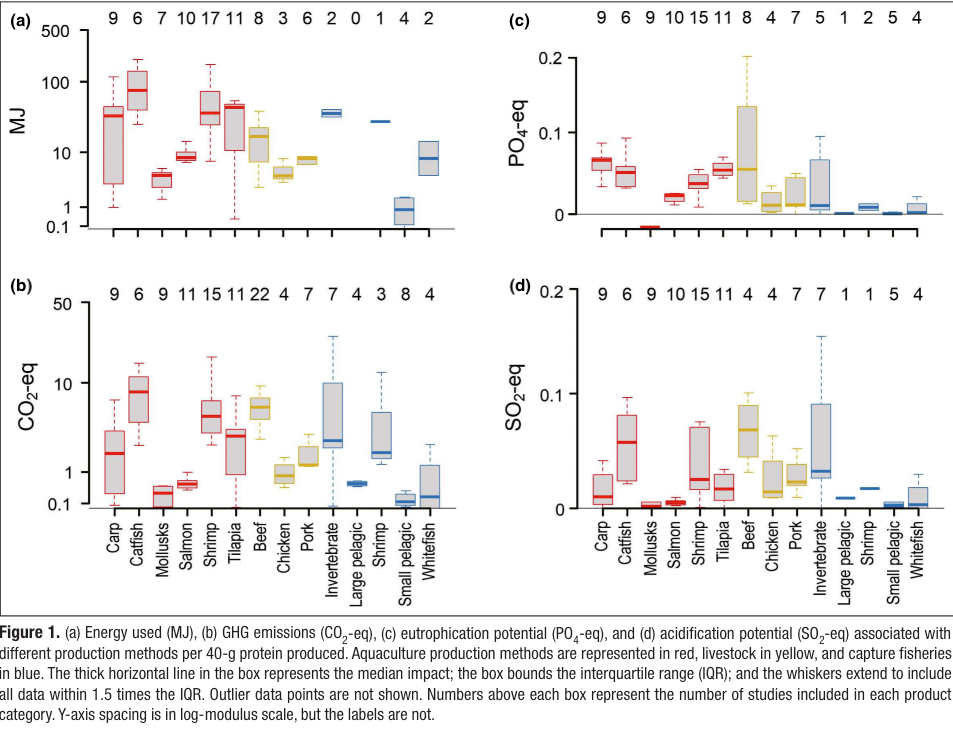
Second, chicken and fish farming do badly on other environmental outcomes. Both are water-guzzlers: just one egg takes 50-60 gallons of water to produce — twice as much as a serving of famously thirsty almonds. And as the graph above shows, most fish farming systems have similar eutrophication potential to beef production (i.e. they pump excess nutrients into waterways, causing algal blooms and dead zones).
White meat’s environmental impacts are also typically more concentrated than beef’s. While only about 11M of the US’ 94M cattle are in feedlots at any time, almost all of the nation’s 1.6B broilers and 470M egg laying hens and pullets are concentrated in factory farms. Just outside of Washington DC, almost a billion birds are raised on the Delmarva Peninsula every year. Based on USDA averages, they likely generate about 28B pounds of manure and 380M pounds of nitrogen every year, causing local environmental havoc.
Third, plant-based foods have the smallest carbon footprints of all. A 2016 study found that while global adoption of a reduced red meat diet could reduce food-related GHG emissions in 2050 by 29% relative to current projections, adoption of a vegetarian or vegan diet could reduce emissions by 63% and 70% respectively. Likewise, the EAT-Lancet report noted that, in its review of studies, “Diets that replaced ruminants with other alternatives, such as fish, poultry, and pork, also show reduced environmental effects, but to a smaller extent than plant-based alternatives.” Even the New York Times’ feature conceded that “a vegan diet does have the smallest climate footprint around.”
And while “realist” environmentalists argue the world will never give up meat, the non-Western world’s protein needs are already mostly met by plants (see below). Indeed, the same is true of traditional Western cuisine: in 1900, two thirds of US protein came from plants, not animals; today the reverse is true. New products may help plant-based proteins regain ground — see Impossible Food’s new nationwide rollout at Burger King, Beyond Meat’s launch at Del Taco, and Clara Foods’ Series B round. (Disclosure: Open Philanthropy invested in Impossible Foods in 2016)
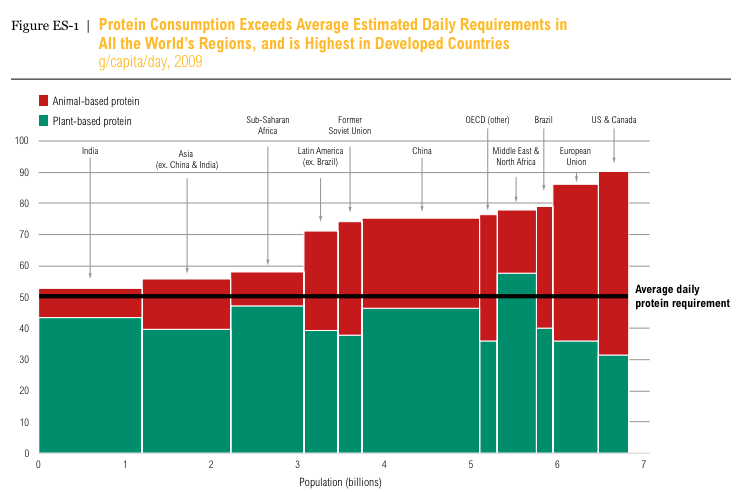
Climate advocates face two broad paths to mitigate animal agriculture’s impact on the planet. One path focuses narrowly on reducing red meat consumption, and will predictably lead to billions more chickens and fish suffering. The other path focuses on reducing all animal product consumption, and promoting plant-based alternatives, and will simultaneously reduce emissions, local pollution, and animal suffering.
Animal advocates should strongly advocate for the second path, as groups like 50by40, ProVeg, and the Good Food Institute are. The point of stopping climate change is to protect the world’s current and future inhabitants, who include the world’s animals. Indeed, the plight of the world’s roughly 25K polar bears may have aided climate advocacy more than any human harm; saving them by mistreating and killing billions more farm animals would be a pyrrhic victory.
